Fibre to Fabric
Animal Fibre — Wool and Silk
Wool:
Wool comes from sheep, goat, yak and some other animals. These
wool-yielding animals bear hair on their body. Hair trap a lot of air.
Air is a poor conductor of heat. So, hair keeps
these animals warm. Wool is derived from these hairy fibres.
Animals that yield wool
Several
breeds of sheep are found in different parts of our country. However,
the fleece of sheep is not the only the source of wool. Sheep wool is
commonly available in the market. Yak wool
is common in Tibet and Ladakh. Angora wool is obtained from angora goats.
Wool
is also obtained from goat hair. The under fur of Kashmiri goat is
soft. It is woven into fine shawls called Pashmina shawls.
The fur (hair) on the body of camels is also used as wool. Llama and Alpaca, found in South America, also yield wool.
From Fibres to Wool
Rearing and breeding of sheep: Shepherds
take their herds of sheep for grazing. Sheep are herbivores and prefer
grass and leaves. Apart from grazing sheep, rearers also feed them on a
mixture of pulses, corn, jowar, oil cakes (material left after taking out oil from seeds) and minerals.
Certain
breeds of sheep have thick coat of hair on their body which yields good
quality wool in large quantities. As mentioned earlier, these sheep are
“selectively bred” with one parent being
a sheep of good breed.
Processing Fibres into Wool
The
wool which is used for knitting sweaters or for weaving shawls is the
finished product of a long process, which involves the following steps:
Step I: The fleece of this sheep along with a thin layer of skin is removed from its body. This process is called shearing.
Step II: The sheared skin with hair is thoroughly washed in tanks to remove grease, dust, and dirt. This is called scouring.
Step III: After scouring, sorting is done. The hairy skin is sent to a factory where hair of different textures are separated or sorted.
Step IV:
The small fluffy fibres, called burrs, are picked out from the hair.
These are the same burrs which sometimes appear on your sweaters. The
fibres are scoured again and dried. This
is the wool ready to be drawn into fibres.
Step V: The fibres can be dyed in various colours, as the natural fleece of sheep and goats is black, brown or white.
Step VI:
The fibres are straightened, combed and rolled into yarn. The longer
fibres are made into wool for sweaters and the shorter fibres are spun
and woven into woollen cloth.
Wool industry
is an important means of livelihood for many people in our country. But
sorter’s job is risky as sometimes they get infected by a bacterium,
anthrax, which causes a fatal blood
disease called sorter’s disease.
Silk
Silk
fibres are also animal fibres. Silkworms spin the ‘silk fibres’. The
rearing of silkworms for obtaining silk is called sericulture.
Life History of Silk Moth
The
female silk moth lays which hatch larvae which are called caterpillars
or silkworms. They grow in size and when the caterpillar is ready to
enter the next stage of its life history called pupa, it first weaves a
net to hold itself. During these movements of the head, the caterpillar
secretes fibre made of protein which hardens on exposure to air and
becomes silk fibre. Soon the caterpillar completely covers itself by
silk fibres. This covering is known as cocoon. The further development
of the moth continues inside the cocoon. Silk fibres are used for
weaving silk cloth. Can you imagine that the soft silk yarn is as strong
as a comparable thread of steel.
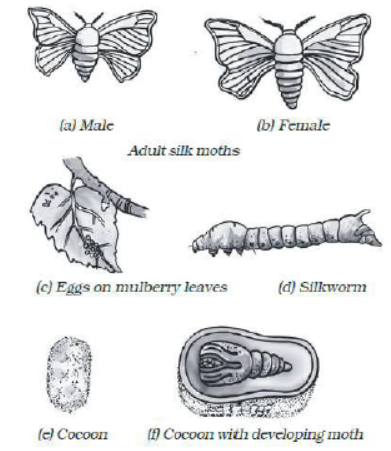
The
silk yarn (thread) is obtained from the cocoon of the silk moth. There
is a variety of silk moths which look very different from one another
and the silk yarn they yield is different in texture (coarse, smooth,
shiny, etc.). Thus, tassar silk, mooga silk, kosa silk etc., are
obtained from cocoons spun by different types of moths. The most common
silk moth is the mulberry silk moth. The silk fibre from the cocoon of
this moth is soft, lustrous and elastic and can be dyed in beautiful
colours.
From Cocoon to Silk
Rearing
silkworms: A female silk moth lays hundreds of eggs at a time. The egg
are stored carefully on strips of cloth or paper and sold to silkworm
farmers. The farmers keep eggs under hygienic conditions and under
suitable conditions of temperature and humidity.
The
eggs are warmed to a suitable temperature for the larvae to hatch from
eggs. This is done when mulberry trees bear a fresh crop of leaves. The
larvae, called caterpillars or silkworms, eat day and night and increase
enormously in size.
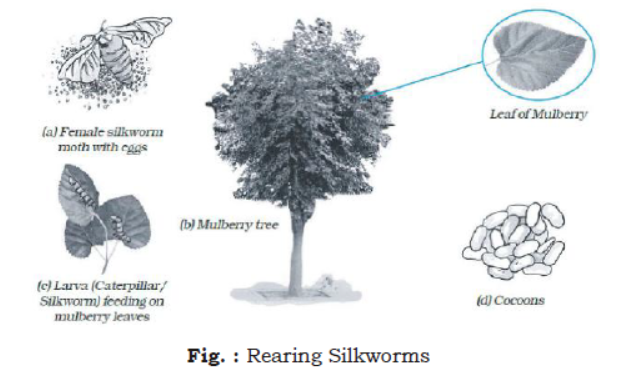
The
worms are kept in clean bamboo trays along with freshly chopped
mulberry leaves. After 25 to 30 days, the caterpillars stop eating and
move to a tiny chamber of bamboo in the tray to spin cocoons. Small
racks or twigs may be provided in the trays to which cocoons get
attached.
The caterpillar or silkworm spins the cocoon inside which develops the silk moth.
Processing silk:
A pile of cocoons is used for obtaining silk fibres. The cocoons are
kept under the sun or boiled or exposed to steam. The silk fibres
separate out. The process of taking out threads from the cocoon for use
as silk is called reeling the silk.
Polymers
Polymers
are high molecular mass substances consisting of large number of
repeating structural units derived from simple molecules called as
monomers.
Monomers: The simple
molecules which combine to give polymers are called monomers. The
process by which the simple molecules (i.e. monomers) are converted into
polymers is called polymerisation.
Homopolymer: A polymer formed from one type of monomers is called homopolymer. For example.
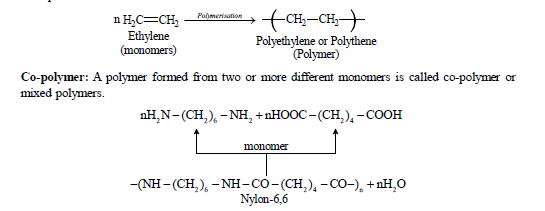
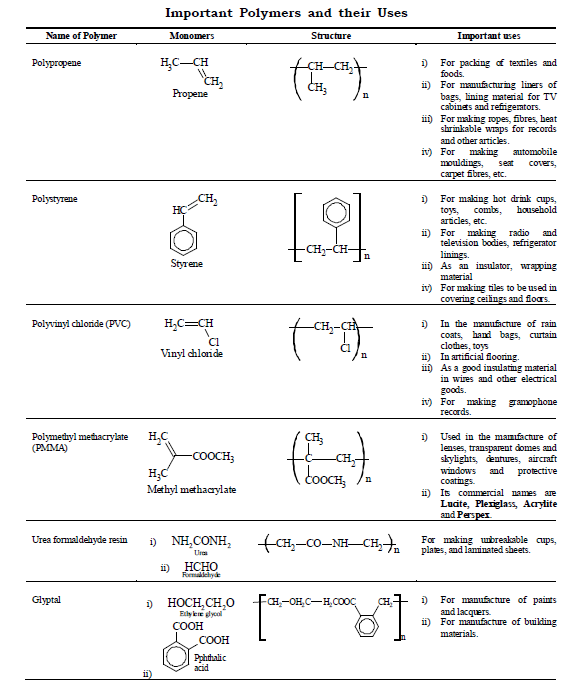
Classification of Polymers on the Basis of Molecular Forces
A
large number of applications of polymers depend upon their mechanical
properties such as tensile strength, elasticity, toughness, etc.
Depending upon the intermolecular forces, the polymers have been classified into four types:
1. Elastomers 2. Fibres
3. Thermoplastics 4. Thermosetting polymers
1. Elastomers: The polymers that have elastic character like rubber are called elastomer E.g. buna-S, buna-N etc.
2. Fibres: These
are the polymers which have strong intermolecular forces between the
chains. The common examples are nylon-66, terylene, silk etc.
3. Thermoplastics: These
are the polymers which can be easily softened repeatedly when heated
and hardened and cooled with little change in their properties. Common
example of thermoplastics are polythene, polystyrene, polyvinyl
chloride, teflon, etc.
4. Thermosetting polymers: These are the polymers which undergo permanent change on heating. The common examples are bakelite, melamine, formaldehyde etc.
Natural and Synthetic Rubbers
Natural Rubber: Rubber
is a naturally occurring polymer. It is obtained as latex from rubber
trees. Rubber latex is a colloidal suspension of rubber in water. Rubber
trees are found in tropical and semi-tropical countries such as India
(southern part), Malaysia, Indonesia, Ceylon, South America, etc. It is
highly elastic. It can be Elastically deformed but regains its original
shape after the stress is relieved. This elasticity makes it a valuable
for variety of uses.
Natural rubber is a polymer of isoprene (2-methyl buta-1, 3-diene)
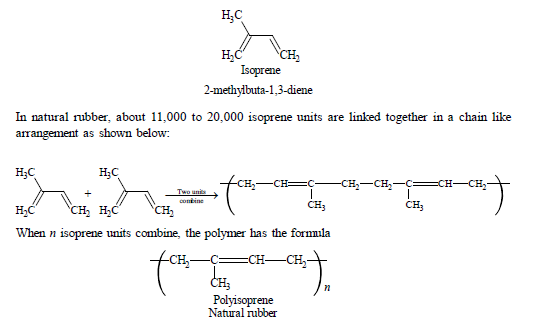
Vulcanization of Rubber
The process of heating natural rubber with sulphur to improve its properties is called vulcanization.

